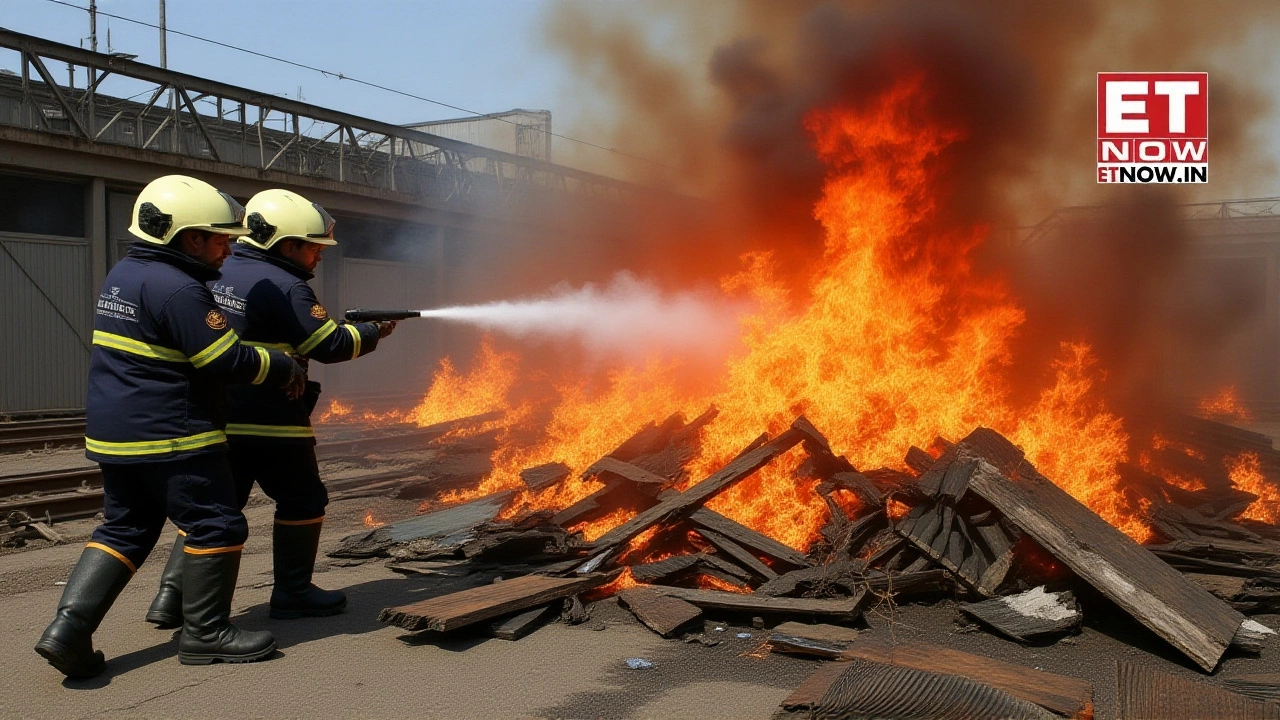A sudden, violent fire tore through the tightly packed shanties of Dharavi on Saturday, November 22, 2025, sending thick black smoke billowing over the Harbour line railway tracks between Bandra and Mahim. The blaze, which erupted around 12:15 p.m. near the Navrang Compound on the 60-foot road, forced Western Railway to cut power to overhead lines and suspend all local train services for more than three hours — a critical disruption in a city that moves on its rails. By 3:40 p.m., the fire was fully extinguished. Miraculously, no one was hurt. But the damage? It was devastating.
How a Cooking Cylinder Ignited Chaos
Eyewitnesses described a scene of sudden panic. Ashraf Shaikh, who lives in the last untouched gala along the railway edge, recalled hearing two sharp blasts — then flames leaping from a ground-plus-one building. "It started on the first floor," he said. "People were cooking lunch. The ground floor? Waste sorting, drug users sleeping, all of it packed together like sardines." The structure, built with flammable materials and crammed with gas cylinders, became a tinderbox. Within minutes, the fire jumped to adjacent homes and small shops, some of which stored plastics, fabrics, and chemicals. The explosions were loud enough to be heard blocks away. "You could feel the heat even from the train platform," said a commuter waiting at Bandra station.Firefighting Response: Eight Engines, No Time to Waste
The Brihanmumbai Municipal Corporation (BMC) Fire Brigade responded with eight fire engines and ten jetties — a massive deployment for a slum fire. Senior officials arrived within 12 minutes, but narrow alleys and crumbling infrastructure slowed progress. Firefighters had to manually drag hoses through mazes of corrugated tin and makeshift staircases. "It’s not like fighting a building fire," said one firefighter, speaking off-record. "Here, you’re dodging gas cylinders, live wires, and people running in all directions. We had to cut power before we could even get close." The delay in reaching the core of the blaze meant the fire burned for over three hours before being fully contained.Railway Disruption: A City Comes to a Standstill
For Mumbai, where over 7.5 million people rely on suburban trains daily, even a short halt is catastrophic. Services between Bandra and Mahim were suspended immediately. The ripple effects were immediate: Western Railway imposed speed restrictions on adjacent lines, slowing down express trains heading to Andheri and Churchgate. Commuters who normally transferred between Harbour and Western lines found themselves stranded. Many walked onto the tracks to reach functioning sections — a dangerous but common sight during such disruptions. Service resumed partially at 2:11 p.m. with trains crawling at 10 kmph. Full normalcy didn’t return until 3:34 p.m. for the down line, and 3:40 p.m. for the up line.
Why This Keeps Happening
This wasn’t an isolated incident. In the past five years, at least seven fires have broken out in Dharavi’s informal settlements adjacent to railway lines. Each time, the same pattern: gas cylinders, overloaded electrical wiring, and no firebreaks. The BMC has repeatedly flagged these zones as high-risk, but relocation efforts have stalled due to bureaucratic delays and lack of affordable housing. Meanwhile, the railway authority has limited power to enforce safety standards on private, unregistered structures. "We disconnect power when fires happen," said a Western Railway spokesperson. "But we can’t go in and remove gas cylinders. That’s not our jurisdiction."Losses and Lingering Questions
Initial estimates from Hindustan Times put property damage at "lakhs of rupees" — roughly $2.3 million — with over a dozen homes and small businesses destroyed. No deaths. No injuries. That’s the miracle. But the human cost? Unmeasured. Families lost everything: savings kept in cash, tools for tailoring, stock for street vendors, even photos of loved ones. The BMC has promised a survey to assess losses and provide temporary relief, but no timeline has been given. The cause remains under investigation, though the gas cylinder theory is the strongest lead.
What Comes Next?
Local leaders are calling for emergency safety audits along all railway corridors in Dharavi. Activists are demanding the implementation of a 2019 BMC-approved fire safety code for slums — a document gathering dust on a shelf. Meanwhile, commuters are left wondering: how many more fires will it take before something changes? The railway system can’t function without these neighborhoods. But these neighborhoods can’t survive without the railway either. It’s a cycle of dependence and danger — and right now, the balance is tipping toward disaster.Frequently Asked Questions
Why didn’t the fire spread to the trains?
Western Railway immediately cut power to the overhead electric lines that supply EMU trains, removing the risk of electrical sparks igniting the blaze or causing a short circuit. The fire was contained on the eastern side of the tracks, and trains were held at safe distances. No train was ever in proximity to the flames, and all passengers were kept off the affected section during the suspension.
How often do fires like this happen near Mumbai’s railway lines?
At least seven major fires have broken out in informal settlements adjacent to Mumbai’s suburban rail lines since 2020, mostly in Dharavi, Kurla, and Ghatkopar. Each incident follows a similar pattern: gas cylinder explosions, poor construction materials, and no firebreaks. The BMC has identified over 40 such high-risk zones, but enforcement remains weak due to jurisdictional confusion between municipal and railway authorities.
Who is responsible for fire safety in slums next to railway tracks?
Legally, the Brihanmumbai Municipal Corporation is responsible for fire safety in slums. But since the structures are built on railway land, Western Railway claims they can’t enter without permission. This jurisdictional gray area has persisted for decades. Neither body has the authority to forcibly remove gas cylinders or retrofit buildings — leaving residents trapped in unsafe conditions.
What’s being done to prevent future fires in Dharavi?
The BMC’s 2019 Slum Fire Safety Code mandates firebreaks, gas cylinder storage rules, and community fire wardens — but only 12% of Dharavi’s 200+ wards have implemented it. A 2024 audit showed that 87% of slum homes still store gas cylinders indoors. No new funding has been allocated since 2023, and relocation projects have stalled due to land disputes. For now, the only "solution" is reactive: cut power, send fire engines, and hope for the best.
Why were train services restored so slowly after the fire was out?
Even after the flames were extinguished, engineers had to inspect every overhead wire, signal system, and track segment for heat damage, soot buildup, or structural weakness. The intense heat warped metal components, and smoke residue affected insulation. Speed restrictions were imposed until inspections were complete — a standard safety protocol. Full restoration took until 3:40 p.m., nearly three hours after the fire was doused.
Is there any compensation for those who lost property?
The BMC has not announced any formal compensation scheme. Residents are being advised to file claims with local ward offices, but without formal property titles — common in slums — proving ownership is nearly impossible. NGOs like the Dharavi Development Trust are stepping in with emergency aid: food, blankets, and temporary shelter. But long-term rebuilding? That’s still uncertain.
